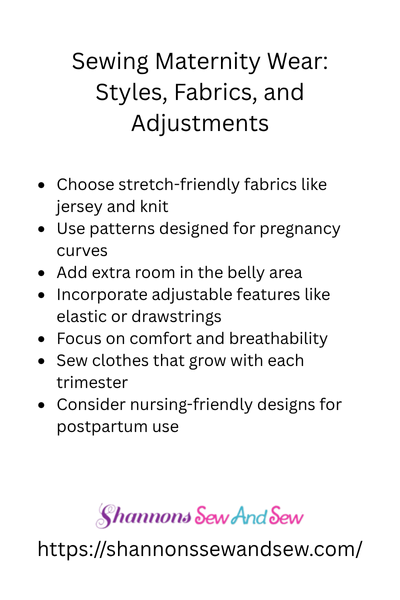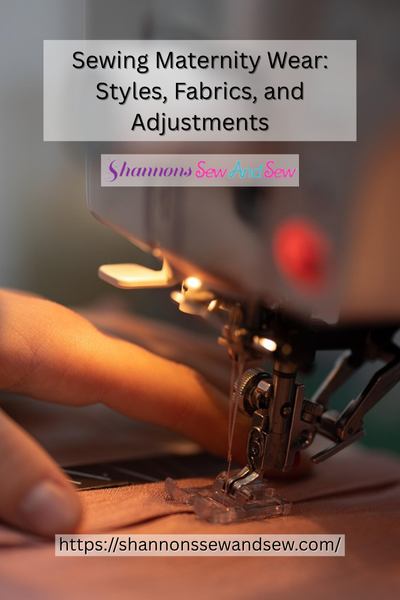Sewing Clothes
Sewing Maternity Wear: Styles, Fabrics, and Adjustments
Sewing maternity wear may sound like a challenge, but with the right styles, fabrics, and a few smart adjustments, you can create pieces that are both functional and fabulous. If you’re like me, and you’ve had the itch to try making your own maternity clothes (whether for yourself, a loved one, or a client), then let’s dive into the exciting world of sewing for pregnancy.
Maternity wear is one of those categories where comfort and style go hand-in-hand. You want something that looks great but also lets you breathe, stretch, and move around. So, how do we strike that perfect balance? Let’s break down the styles, fabrics, and adjustments that will make your sewing projects a total win.
Read More About Sewing Maternity Wear: Styles, Fabrics, and Adjustments

Finding the Right Styles for Maternity Wear
When it comes to maternity wear, the goal is to create something that will grow with the wearer. The classic “belly band” is the first thing most people think about, but there’s so much more to explore. From dresses to tops, skirts, and even pants, you can sew a variety of garments that are both functional and stylish.
For tops, you’ll want to look for styles that allow for movement—think empire waistlines, wrap tops, or A-line cuts. These styles offer plenty of room for the groing belly without sacrificing style. I made a simple maternity wrap dress a while ago, and let me tell you, it quickly became my go-to. It’s flattering, adjustable, and easy to make!
For pants and skirts, an elastic waistband or stretchy fabric is a must. As your body changes, you’ll need garments that can stretch and adapt to those changes. Sewn-in waistbands with a bit of extra space for comfort are a great option, or you can go full elastic waistband—either way, make sure it’s something the wearer can easily pull on and off.
I remember making a pair of maternity jeans once. At first, I was intimidated by the thought of sewing denim with stretchy panels, but it was so much easier than I thought. The trick is finding that sweet spot of stretchiness that provides comfort without being too tight.
More Things to Know About Sewing Maternity Wear: Styles, Fabrics, and Adjustments

Choosing the Best Fabrics for Comfort and Style
When sewing maternity wear, the fabric you choose can make or break the project. Comfort is key, but you also want to ensure the fabric can hold up through wear and washing. Look for fabrics that have some stretch to them—spandex blends, cotton jersey, rayon, and bamboo are all excellent options.
I recommend using cotton jersey for making maternity tops or dresses. It’s soft, breathable, and stretchy, which is perfect for those long days when comfort is everything. I made a tank top with a cotton jersey fabric during one of my early maternity sewing projects, and it’s still a wardrobe staple.
Another fabric that works well is rayon. It drapes beautifully and has a bit of give, which is perfect for dresses and skirts. Rayon also comes in a variety of beautiful prints, which can add a bit of fun to any maternity wardrobe.
Now, if you’re tackling a pair of maternity pants or shorts, you might want to look into fabrics like denim with some spandex for that extra stretch or even a nice stretchy twill for a more polished look. What I love about stretchy denim is that it offers structure, but still gives the room to breathe and move—perfect for growing bellies.
Adjusting Patterns for a Growing Belly
One of the most important aspects of sewing maternity wear is making sure the patterns are adjustable for a growing belly. Many commercial patterns don’t quite accommodate the changes in body shape, but you can easily make a few modifications.
If you’re working with a pattern that isn’t designed specifically for maternity wear, the first thing I’d suggest is adding some extra room around the belly. You can do this by adding a couple of inches to the front panel or modifying the side seams to create more space. I’ve done this with a simple tunic pattern before, and it worked wonders.
Another thing to keep in mind when sewing maternity wear is to make sure the fabric you choose has enough give to it. The last thing you want is for the garment to lose its stretch after a few wears and washes. Fabrics with a bit of spandex or elastane are perfect for this purpose, as they’ll hold their shape even as the wearer’s body changes.
If you’re nervous about making these adjustments, don’t be! I was too, at first. The best advice I can give you is to take your time with these changes. Remember that sewing is a process, and you’ll only get better with practice.
My Personal Experience Making Maternity Wear
Let me share a little personal experience with you. When I first started sewing maternity wear for myself, I was nervous. I didn’t know if I’d be able to make something that not only fit well but also looked good. The first project I tackled was a simple maternity dress. I was surprised at how easy it was once I got going! The fit wasn’t perfect on the first try, but that didn’t stop me—I made a few adjustments, and the dress turned out great.
As I kept making more pieces, I began to understand the importance of fabric choice, pattern adjustments, and how the wearer’s body changes over time. Maternity wear is all about comfort, and once I figured that out, sewing for pregnancy became one of my favorite things to do.
Ready to Create Maternity Pieces That Truly Fit
Sewing maternity wear doesn’t have to be intimidating. With the right styles, fabrics, and adjustments, you can create pieces that are both comfortable and stylish. From stretchy fabrics like cotton jersey to adjustable waistbands and smart pattern modifications, you’ve got everything you need to make maternity clothes that will grow with the wearer.
So, whether you’re sewing for yourself or a friend, just remember to keep comfort at the forefront and have fun with the creative process. I’ve learned so much along the way, and I can’t wait to see what you create. Happy sewing.




















